Themes > Features
22.05.2003
Revisiting Post-Reform Industrial Performance
Recently
released figures suggest that as per the provisional index of industrial
production, industrial growth during 2002-03 stood at 5.8 per cent, as
compared with 2.7 per cent in 2001-02 (Chart 1). This has been interpreted
as suggestive of a return to buoyancy after a two year period of
sluggishness in the industrial sector. However, the case for such optimism
is indeed limited. To start with, the 5.8 per cent figure reflects a
performance lower than recorded during 6 out of the last 10 years and is
way below the 9.1 and 13 per cent rates of growth recorded in 1994-95 and
1995-96 respectively. Secondly, coming after the poor performance of
2001-02, this figure does not help rectify the fact that the trend rate of
growth since the economic reform began in 1991-92 has been lower than that
recorded during the 1980s. Ignoring the immediate post-adjustment years
1991/92 and 1992/93 when industrial growth slumped because of import
compression and fiscal adjustment, the trend rate of growth during the
10-year period 1993/4-2002/3 was at 6.3 per cent short of the 6.7 per cent
per annum trend rate of growth recorded during the years 1981/82-1990/91.

It is indeed true that the IIP is only a lead indicator, that in the past
has been known not to reliably capture actual trends in the registered
industrial sector as revealed by output and value added figures from the
Annual Survey of Industries (ASI), that become available only after a two
year gap. An index capturing movement in production as suggested by
inter-temporal production relatives, the reliability of the IIP can be
adversely affected by its inadequate coverage and persistent problems of
poor response from reporting units. However, during the 1990s the IIP
growth figures as revealed by the GDP at factor cost in registered
manufacturing, which are available separately for 1990-91 to 1994-95 with
1980-81 as base and for 1994-95 to 1999-2000 with 1993-94 as base, point
to a similar trend as the IIP over time, though the figures using base
1993-94 yield much higher growth rates than both the older National
Accounts Series and the IIP.
Overall it appears that during the 1990s the IIP does provide a reasonable
guide to industrial trends despite its many shortcomings. Using the IIP
therefore, we could argue that after falling sharply in 1991-92 as a
result of the import compression and stabilisation resorted to by the
government in response to the balance of payments crisis, industrial
growth recovered quite well, rising to 6.0 per cent in 1993-94, 9.1 per
cent in 1994-95 and 13 per cent in 1995-96. After that, however, the
industrial sector has witnessed a downturn, with the rate of growth
falling to 6.1 and 6.7 per cent in 1996-97 and 1997-98 and slipping
further to 4.1 per cent in 1998-99. There were signs of a recovery in
1999-2000 with the rate rising to 6.7 per cent, but subsequently the pace
of growth has slackened substantially, standing at just 5 per cent during
2000-01 and 2.7 per cent in 2001-02.
In sum, the trend growth rate in the IIP since the reform, is not just
lower than what was seen during the 1980s, but conceals two periods of
sharply divergent trends: a period of recovery and growth during the first
half of the 1990s, followed by a period of slump during the second half of
the 1990s, which has recently been aggravated, after a brief promise of a
possible return to growth in 1999-00. With the overall trend of the second
half of the 1990s persisting into the first half of the first decade of
the new century, we can safely conclude the growth has indeed turned
sluggish despite individual years of near-average performance.
These tendencies are revealed more clearly in Charts 2 and 3, which
provide the month-on-month annualised rates of growth in the general index
and the IIP for manufacturing during the period starting after the
recovery in 1994-95. They suggest (i) that there have been three troughs
since then: one centred around January 1997, the second around October
1998 and the third around May 2001; (ii) that the recovery after each of
these troughs has not been strong enough to restore the high rates of
growth recorded during the mid-1990s; (iii) that the peak in each of these
cycles has been lower than the one preceding it; and (iv) the trends in
the general index have been driven by the trends in the manufacturing
sector as reflected by the manufacturing component of the IIP. These
features emerge from Chart 4 as well, which takes a closer look at the
years of the down turn, by examining quarterly growth trends (relative to
the corresponding quarter of the previous year) in the general index as
well as manufacturing IIP for the period stretching between the second
quarter of 1995 and the first quarter of 2003. The picture here is more
complex. From a peak of close to 15 per cent in manufacturing and just
below 14 per cent in the case of the general index, growth slumped to a
low of less than 3 per cent in the first quarter of 1997. This was
followed by a recovery that lasted three quarters, which took
manufacturing growth to 9 per cent. But the recovery proved short-lived
and Indian industry once again experienced a slump till the third quarter
of 1998.In the next four quarters there was yet another phase of recovery,
with manufacturing growth touching close to 10 per cent in the third
quarter of 1999. But the downturn returned and proved to be much longer
and sharper, bringing the growth rate down to 2.5 per cent in the third
quarter of 2001.Though there has been a recovery since then, the
quarter-on-quarter rate of growth seems to have peaked at around 6 per
cent.



Charts 5-10 examine these annual growth trends separately for the major
use-based industrial categories. It is clear that basic goods and
intermediate goods display more or less the same trends as the overall
manufacturing index, though the degree of sluggishness after the mid-1990s
is greater in the case of intermediate goods. The difference really arises
in the capital and consumption goods categories. The capital goods sector
(Chart 6) appears to have a rather volatile record of growth during the
1990s with quite a few years of creditable growth (1994/95, 1996/97 and
1998/99), a period of extremely poor performance during 1999-00 and
2000-01 when growth rates collapsed and a stronger recovery in 2002-03
than in most other sectors. One possible way in which this could be
interpreted is that investment in other sectors responds with a lag to any
production downturn, resulting in longer-periods of buoyancy in the
capital goods sector and much sharper cuts in production when the downturn
sets in. This implies a substantial degree of irrationality that leads to
larger unutilised capacity in the manufacturing sector. The recovery in
demand for and production of capital goods in 2002-03 could also be seen
as partly reflective of such irrationality.


The other sector which has gone against the grain in terms of annual rates
of growth is consumption goods. In keeping with overall trends, the rate
of growth of consumption goods production did fall sharply after the
mini-boom during 1994-96 (Chart 8). But since 1999-00 that sector has
registered rather consistent creditable (even if not high) rates of
growth. What is more, while both consumer durables and non-durables played
a major role in the mid-1990s boom in consumption goods production as well
as the subsequent collapse in growth, post-1999 performance has been
driven in most years by consumer durables production. However, the
above-average performance of the sector in 2002-03 occurred despite a
sharp fall in consumer durables production, because of a remarkable 12.3
per cent rate of growth of non-durable consumer goods production. While
the good performance of consumer durables in most years is in part the
result of the consumer credit boom that financial liberalisation has
unleashed, the performance of consumer non-durables in the most recent
year still remains a puzzle.


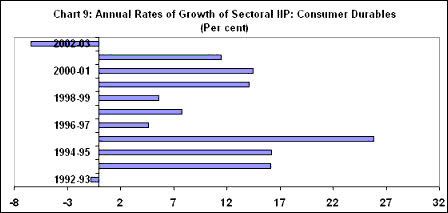

A caveat is called for at this point. It is well known and widely accepted
that the reliability of the IIP declines when we move to more
disaggregated levels of industry. Further, there is a substantial degree
of overlap between the capital and consumer non-durable categories.
Automobiles, purchases of which for personal use rose substantially during
the 1990s, are included in the capital goods category. So are electronic
goods of certain kinds that would be more appropriately classified as
consumer-durables. This overflow of consumer durables into the capital
goods category makes it difficult to assess the degree to which any slump
or recovery in capital goods is driven by consumer durables. It also
implies that the small weight of consumer durables in the overall index,
does not do full justice to the importance of this sector from the point
of view of industrial growth.
All this is of relevance when we seek to explain the process of growth and
industrial deceleration during the 1990s. It needs to be recognised that
the liberalisation programme of the 1990s had a number of adverse
implications for manufacturing and industrial growth. To start with, it
was inevitable that import liberalisation would result in some
displacement of existing domestic production either directly by imports or
indirectly by new products assembled domestically from imported inputs.
Second, that the reduction in customs duties resorted to as part of the
import liberalisation package and the direct and indirect tax concessions
that were provided to the private sector to stimulate investment,
especially starting with the budget of 1993-94, would lead to a
significant reduction in the tax-GDP ratio at the Centre by anywhere
between 1.5 to 2 percentage points of GDP. This implied that the fiscal
stimulus associated with any given level of the fiscal deficit would be
lower than would have otherwise been the case. Finally, after some initial
slippage in the deficit reduction effort, which took the fiscal deficit to
relatively high levels in 1993-94, the government has managed closer even
if not full adherence to fiscal deficit targets, so that the stimulus
provided to industrial growth by state expenditure was substantially
smaller than was the case in the 1980s.


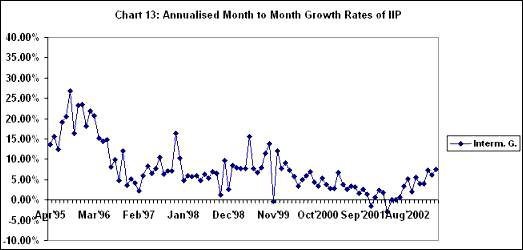
It is despite all this that India witnessed the three-year mini-boom in
industrial growth during 1993-94 to 1995-96, which as we have seen has had
an overwhelming influence on the trend rate of industrial growth during
the 1990s. The explanation for this boom, despite the adverse consequences
of liberalisation for growth in industry, lies in the effects of
liberalisation on demand. It has been known for some time that one
consequence of the complex of import substitution policies pursued by
India till the mid 1980s was the pent-up demand for a range of
manufactured goods, including specific brands of such goods. While
knowledge of these could be acquired by consumers and producers from the
international market, the products themselves could either not be acquired
within India or acquired only at prohibitive costs. Liberalization of the
kind pursued in India, which freed access to intermediates, components and
capital goods while protecting most end-products, along with reducing
tariffs substantially, allowed for the expansion of domestic
production/assembly and sale of these commodities in a relatively short
span of time. This occurred at two levels : first, by relatively small
firms that combined cheap imports and domestic parts to service what is
not always correctly described as the "grey market"; and second, by larger
firms, very often in collaboration with international producers with a
well-cultivated brand image.
While such products did have a ready market, they would not have
contributed to a net addition to domestic production to the extent that
they displaced similar or other products in the consumer's basket of
purchases. If the availability of new goods were to spur growth it needed
to be accompanied by a net accretion to demand after accounting for the
displacement of previously available "substitutes". In the short run such
net additions to demand can be financed either with the flow of hitherto
unaccounted incomes into the market for goods, or with an element of
dissaving reflected by reduced financial savings, or through increased
recourse to consumer credit. There is reason to believe that in much of
urban India and some parts of rural India, such a tendency was underway,
driven by easier access to credit, including consumer credit provided to
individuals.
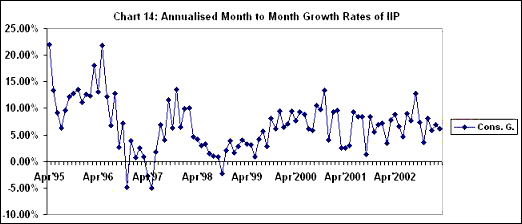
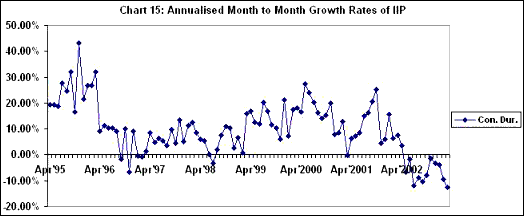
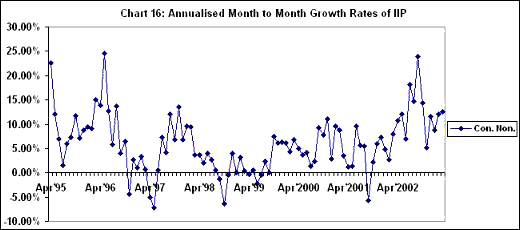
The 1993-1995 "mini-boom" was thus the result of a combination of several
once-for-all influences, in particular the release of the pent-up demand
for a host of import-intensive goods, which (because of liberalization)
could be serviced through domestic assembly or production using imported
inputs and components. Once that demand had been satisfied, further growth
had to be based on an expansion of the domestic market or a surge in
exports. Since neither of these conditions was realised, industry then
entered a phase of slow growth, though the percolation of such demand to
lower income deciles facilitated by the consumer credit boom, kept
consumption goods growth going at above average levels in many years. That
is, the phenomenon of ‘pent-up' demand was not restricted to those who had
the wherewithal to realize it as soon as supply-side constraints to their
realization were removed. The tendency existed among other sections as
well, and could realise itself in the form of actual demand because
financial liberalisation, which had as its corollary the entry of new
financial players into the market and the diversification of banks and
non-bank financial companies into new areas of lending that promised
higher returns, resulted in a boom in consumer credit that substantially
increased the number of people who could lumpy purchases. Further, the
‘windfall gains' registered by a significant number of central and state
government employees as a result of the payment of arrears following of
the implementation of the Fifth Pay Commission's recommendations, also
contributed to n increase in the number having the wherewithal to
contribute to such demand. It is indeed true that while industrial firms
and rich agriculturalists contributed to such pent-up demand as well, the
bulk of such purchases would be of consumer durables by households. This
explains the more consistent performance of the consumer durables sector.
It follows that when such demand is satiated and cannot be sustained any
further, the overall tendency is towards slower industrial growth on
average if other stimuli such as state expenditure do not substitute for
the once-for-all stimulus, as was true by the end of the decade.
© MACROSCAN
2003